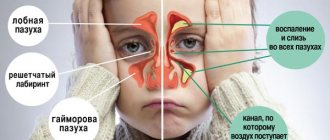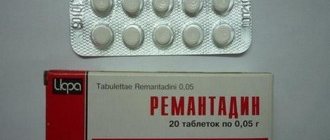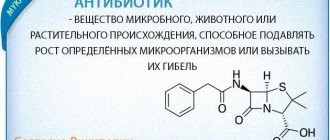Antibacterial drugs have a selective effect. They destroy exclusively pathogenic cells that provoke the development of a cold. How do medications “distinguish” pathogens from human cells?
Bacterial cells have a mesh structure, while human cells are enclosed in a special membrane. This allows the active components of antimicrobial agents to identify and destroy pathogens.
Some groups of drugs inhibit the activity of bacteria, disrupting the process of synthesis of daughter cells, while others destroy the cellular structure of microorganisms, which leads to their death.
When can it be used?
Antibiotics should only be used against colds and flu if there are serious complications. Colds are caused by viruses, not bacteria. For this reason, treatment of uncomplicated ARVI with antibacterial tablets will be useless.
The presence of complications in most cases signals the addition of pathogenic bacteria to the viral infection. Only in such cases the use of antibacterial therapy will help cope with the disease. Direct indications for the use of antibiotics for colds are:
Purulent lymphadenitis;- Otitis media;
- Pneumonia;
- Chronic sinusitis;
- Ethmoiditis;
- Bacterial sore throat;
- Sinusitis;
- Chronical bronchitis.
Even mild antibiotics for colds can only be prescribed by your doctor.
Overdose of medications leads to dysbiosis and weakening of the body's immune defense. Subsequently, this causes a deterioration in health and the development of severe complications.
Can children be given antibiotics?
If a viral disease occurs, you should never immediately start giving your child antibiotics, as this can be very dangerous. Medicines should be prescribed after examination and identification of the cause of the disease. It is worth remembering that taking drugs that inhibit the activity of bacteria can either help the body cope with the disease or harm it.
The dosage of the antibiotic is prescribed based on the following factors:
- The severity of the disease;
- The causative agent of the disease;
- Child's height and weight;
- Pathological abnormalities of the body, if any.
ARVI and influenza in children are subject to the same treatment as in adults, but antibiotics are prescribed only as a last resort. The use of antibiotics for acute respiratory infections is justified when:
- Frequent colds and viral infections;
- The presence of HIV infections, cancer and congenital disorders of the immune system;
- Severe underweight, developmental defects, rickets;
- Maintaining a constant elevated body temperature;
- The presence of acute otitis media, streptococcal sore throat of the aerobic type;
- Inflammation of the paranasal sinuses in the nose.
As a rule, children are prescribed flemoxin, sumamed or amoxicillin. Amoxicillin is the most popular among pediatricians because of its convenient release form: the drug is produced in the form of ampoules for injections and suspensions of 125 or 250 mg.
Some antibiotics, such as levomecithin or ceftriaxone, can cause undesirable effects when taken by a child under 3 years of age. Side effects include allergic reactions, nausea, dysbiosis, vomiting and general intoxication of the whole body.
Classification of antibacterial drugs
What antibiotics should I take for a cold? There are several types of medications that can be prescribed to treat colds.
The choice of a specific medication depends on the etiology of the disease, the severity of complications and the patient's medical history.
Conventionally, all antibiotics are divided into several groups:
- Penicillins are medications that have a pronounced antibacterial effect. They are active against most pathogenic bacteria that cause inflammation in the respiratory system. The active components of penicillin drugs contribute to the destruction of the walls of pathogens, which causes their death. Penicillins have low toxicity, so they can be used in pediatric therapy to eliminate complications of ARVI and influenza;
- Cephalosporins are drugs with a bactericidal effect that destroy the cellular structure of bacteria. An antibiotic is prescribed for colds and coughs caused by pneumonia, pleurisy, bronchitis, etc. Cephalosporins are available in the form of injection solutions for intravenous and intramuscular administration. This is due to the ability of drugs to provoke irritation of the gastric mucosa and digestive tract;
Macrolides are drugs that have a bacteriostatic effect. Used to treat atypical pneumonia and severe complications after influenza. They rarely cause adverse reactions and can be used instead of penicillins to treat patients prone to allergies;- Fluoroquinolones are effective means of combating gram-negative microorganisms, which include chlamydia, microplasma and pneumococci. This is the best antibiotic for colds, which in very rare cases causes allergies due to its non-toxicity.
Groups of antibiotics for colds
When choosing which antibiotics to take for a cold, they are guided by the localization of inflammation, the nature and intensity of the manifestation of the disease.
Usually, immediately upon treatment, a patient is prescribed broad-spectrum antibiotics that act on most typical pathogens of nasopharyngeal inflammation.
Then, according to the bacterial examination, either the course of treatment is continued, or the antibiotic is changed to one more sensitive to pathogenic microflora.
The list of antibiotics for colds includes drugs from the penicillin and cephalosporin series, macrolides, and fluoroquinolones.
Penicillins
A large group of penicillins is represented by Ampicillin, Augmentin, Amoxicillin, Amoxiclav, Flemoxin Solutab, Amosin, Ecobol, Benzicillin, Bicillin.
Penicillins are effective antibiotics for flu and colds, but treatment with drugs in this group is complicated by the risk of allergies, as well as the instability of the compound to the action of enzymes.
An allergic reaction to penicillins is manifested by skin rash, urticaria, Quincke's edema, and anaphylactic shock. If there is no allergy, the patient is prescribed penicillin before testing the sensitivity of bacteria to antibiotics.
A large number of antibiotics used for colds are based on ampicillin, the most well-known names of the drugs are Ampicillin-AKOS, Ampicillin sodium, Ampicillin trihydrate.
Ampicillin is considered one of the cheapest and most effective antibiotics for colds; an important condition for its use is the absence of an allergy to the penicillin series.
The antibiotic of choice for colds is often amoxicillin + clavulanic acid (Amoxiclav). Clavulanic acid protects amoxicillin from destruction, and the antibiotic limits the growth of bacteria and destroys them.
Amoxiclav analogues, Augmentin, Panclave, Ranclave, Rapiclav, act in a similar way for colds.
Amoxicillin and its analogues are inexpensive antibiotics that help with colds; the prices for these drugs on average do not exceed 150 rubles. The cheapest in tablets and capsules are Amosin (59 rubles), Amoxicillin (60 rubles), Hiconcil (54 rubles).
The price of another amoxicillin analogue, the antibiotic Flemoxin Solutaba, is slightly higher; it is also effective against colds and is approved for children. The average cost of a package in Moscow and St. Petersburg is 300-400 rubles, the tablets have a pleasant taste, they can be dissolved and given in the form of a syrup or suspension to children.
Penicillin antibiotics are considered the safest; they are used in pediatric therapy for colds, inflammation of the bronchi, and lungs; the names of the most prescribed drugs are Amoxicillin, Benzpenicillin, Amoxiclav.
We also suggest that you read the article Tablets for colds.
Macrolides
Macrolide antibiotics are broad-spectrum drugs that are active in cases of upper respiratory tract infections of various origins.
Macrolides are allowed during pregnancy; when choosing which antibiotics to prescribe for a cold, the doctor chooses this group of drugs.
Strong antibiotics for colds include drugs containing azithromycin as an active ingredient.
The most famous drug of this group is Sumamed. The antibiotic is approved for children; 3 tablets are enough for a course of treatment for a cold. The medicine is available in tablets, capsules, and powder is also available for sale to make a suspension.
Azithromycin serves as the main active component of such Sumamed analogs as Azivok, Sumazid Azitral, Sumamed forte, Sumametsin, Hemomycin, Zitrocin, ZI-Factor, Azithromycin monohydrate, Azithromycin dihydrate, Azitrox, Azicide, Azivok.
The peculiarities of absorption and excretion of azithromycin from the body make it possible to use these antibiotics for colds once a day. For a cold, it is enough to take three antibiotic tablets, distributing one every day.
One of the best macrolide antibiotics is Klabax, a semi-synthetic drug of the latest generation. The active ingredient of Klabax is clarithromycin, which suppresses the activity of typical and atypical pathogenic microflora and destroys chlamydia.
The antibiotic Klabaks not only kills pathogenic microflora, but also supports the immune system and prevents the phenomenon of bacteremia - the penetration of bacteria into the blood.
Antibiotic Klabax for prolonged colds promotes the removal of sputum, suppresses respiratory infections of almost all types, and exhibits immunomodulatory properties.
The active component clarithromycin is also included in Ecosetrin, Klacid, Arvicin, Clarbact, Clarithromycin Zentiva, Clerimed, Fromilid. These antibiotics act in a similar way for colds, and which of them to choose for treatment is often determined not only by the doctor, but also by the price.
The most expensive tablets with the antibiotic clarithromycin are Klacid (England, USA) - 953 rubles, 943 rubles, a more affordable price for the drug Clerimed (Cyprus) - 152 rubles. in pharmacies in Moscow and St. Petersburg.
Perhaps you were looking for how to treat a cold during pregnancy? Read more in our article Treatment of colds with medications during pregnancy.
Cephalosporins
Cephalosporins are a large group of drugs that are active against a wide range of pathogens. The properties of 1st and 2nd generation cephalosporins have been well studied.
New drugs from the 3rd and 4th generations are highly effective for respiratory infections and are prescribed to adults. The specifics of using the latest generation of cephalosporins for children have not been fully studied, so children under 18 years of age are prescribed 1st and 2nd generation cephalosporins for treatment.
Fluoroquinolones
Antibiotics of this group are highly active against pneumococci and a number of other pathogens of respiratory diseases. Fluoroquinolones can be used for colds in people over 18 years of age.
Sparfloxacin, moxifloxacin, levofloxacin have a wide spectrum of action, demonstrate effectiveness against highly resistant pathogens, and are used once a day.
The negative side of fluoroquinolones is heart rhythm disturbance. These drugs are prescribed with extreme caution in the elderly.
List of the best drugs
What antibiotics to take for a cold? The selection of suitable medications should only be done by a specialist, and not by a pharmacist at a pharmacy or a friend.
It should be noted that long-term use of antibacterial agents should be accompanied by the intake of probiotics. They prevent the development of dysbiosis and suppression of the body's immune defense.
Effective antibiotics for colds include:
- “Summamed” is a broad-spectrum azalide antibiotic that belongs to the group of macrolides. It is effective in the treatment of sinusitis, atypical pneumonia, otitis media, tonsillitis, Lyme disease and bacterial tonsillitis. Azithromycin, which is part of the tablets, is quickly absorbed into the blood and destroys the cellular structure of pathogens;
- "Avelox" is an antimicrobial agent containing moxifloxacin. Penetrating into the pathogenic cell, the active components of the tablet destroy the DNA hydrase enzyme, which prevents the synthesis of new pathogens. It is a strong cold-relieving antibiotic that fights anaerobic and gram-positive bacteria;
- "Suprax" is a drug of the cephalosparin group that eliminates gram-positive and gram-negative microorganisms in the respiratory system. Unlike penicillin, it is resistant to beta-lactamases and is therefore highly active against most pathogenic bacteria. For an adult with a cold, an antibiotic is prescribed in case of complications such as chronic bronchitis, sinusitis, pharyngitis, otitis media, etc.
The above list of antibiotics for colds is provided for informational purposes.
It is not advisable to use the medicine yourself without consulting a doctor. Home therapy may be ineffective or even contribute to disruption of the intestinal microflora.
Cheap and effective analogues of expensive drugs
Getting sick is becoming extremely expensive these days. Pharmaceuticals have long been engaged not in inventing improved drugs, but in re-releasing old ones with new price tags. Fortunately, there is a way out: cheap drugs are not inferior in effectiveness to their expensive counterparts. So what antibiotics should you take for a cold so that every trip to the pharmacy doesn’t empty your wallet?
If you have a cold, these remedies can help:
- Nitroxoline. An antimicrobial drug that is not an antibiotic; compared to them, Nitroxoline has a milder effect on microorganisms;
- Ampicillin is one of the most widely used drugs. Available in tablet form. Even a child or a pregnant woman can take it, but only under the supervision of a doctor.
- Amosin. An analogue of Amoxicillin, which also has a low cost. It is not recommended for use by pregnant women, as it can penetrate the placenta in large quantities.
Absolutely any drug has its contraindications and unwanted side effects , so antibiotics should be taken based on the doctor’s recommendation. A drug selected taking into account the characteristics and characteristics of the patient will work best. If there is no improvement in the condition after the 3rd day of taking the antibiotic, then you need to consult a doctor again for advice.
Timely treatment will help avoid complications and speed up the recovery process.
Gentle medications for pregnant women
Treatment of cold complications in pregnant women is possible only if the effect of the active components of drugs on the development of the fetus is taken into account. Antibiotics for pregnant women for colds should not contain substances that can be absorbed into the placenta. The safest and most effective in this case are the following medications:
- "Erythromycin" is a penicillin medicine with pronounced antimicrobial properties. The drug is active against staphylococci, meningococci, pneumococci and other gram-positive microorganisms. Quickly copes with inflammatory processes in the ENT organs caused by pneumonia, bronchitis, pneumopleuritis and purulent otitis media;
- "Oxamp" are antibacterial capsules containing ampicillin. Antibiotic injections are used for colds only in the 2nd and 3rd trimester of pregnancy. It allows you to eliminate complications such as pyelonephritis, tonsillitis, pneumonia, cystitis, urethritis, meningitis, etc.;
- "Bioparox" is an inhaled antimicrobial medicine that contains fusafungine. In addition to the bacteriostatic effect, it also has an anti-inflammatory effect, which promotes the regeneration of the mucous membranes of the respiratory organs affected by microbes. The aerosol can be used to treat chronic rhinitis, tonsillitis, sinusitis and nasopharyngitis;
- Minocycline is a semi-synthetic broad-spectrum medicine that effectively fights bacterial infections and post-influenza complications. Can be used as an alternative remedy for allergies to penicillin drugs.
Modern antibiotics used for colds rarely cause allergies. However, when treating pregnant women, doctors recommend taking antihistamines in parallel.
It is also advisable to exclude coffee drinks and citrus fruits from the diet during therapy.
List of types with names of medications for adults
Today, the most effective antibiotics for influenza and ARVI remain:
- Macrolides.
These include Azithromycin, Amoxilicin, Clarithromycin, Erythromycin, Amoxiclav (but can Amoxiclav be used for angina, this article will help you understand). These drugs are among the best and most effective. They are used in the treatment of various inflammatory processes. Take 1 tablet 2 times a day. In the photo - azithromycin - Penicillins.
These include Augment, Ampiox, Ampicillin. These drugs are hypersensitive antibiotics that have a wide range of effects. Take 1 tablet once a day. The duration of treatment and dosage of the medication is determined by the attending physician, taking into account the severity of the cold. The photo shows the drug Augment - Cephalosporins.
This group of drugs includes Ceftriaxone (how to use Ceftriaxone injections for sinusitis is described here in the article), Cefotaxime, Cefazolin. These drugs are among the most effective, as they have a wide antimicrobial spectrum of influence. These medications are most often administered intramuscularly. But the dosage and duration of the course are determined by the doctor. In the photo - ceftriaxone - Fluoroquinolones.
This group of antibacterial drugs should be used in the treatment of influenza to combat the influence of gram-negative bacteria. After the drug of this group penetrates the cell structure, they infect the microbes that are in it. Today, these drugs are considered one of the most non-toxic antibiotics. No allergies are observed when taking them, and fluoroquinolones are safe to use. In the photo - fluoroquinolones
Taking antibacterial medications for a long time is prohibited. In this case, you need to combine them with probiotics. These drugs help restore normal intestinal microflora. These include Linex and Bioyogurt. If they are not used, the intestinal microflora will die, which will lead to dysbiosis.
You may be interested in reading about the differences between the symptoms of influenza and ARVI.
Drugs for the treatment of children
What antibiotics can be used to treat colds in children? Pediatricians do not recommend using antimicrobial medications in pediatric therapy to eliminate infections. But in case of complications such as purulent tonsillitis or acute otitis media, you cannot do without potent drugs.
Some of the safest and least toxic antibacterial drugs include:
"Zinnat" is a cephalosporin medicine that contains cefuroxime. The tablets prevent the synthesis of pathogenic microorganisms by disrupting the cross-linking of peptidoglycans in the cell structure. “Zinnat” eliminates infections not only in the ENT organs, but also in the mucous membranes of the urinary tract;- "Fromilid uno" is a semi-synthetic antibiotic belonging to the group of macrolides. Contains clarithromycin, which inhibits DNA synthesis in pathogens. Antibiotic tablets for colds are active against hospital strains of bacteria. Used to combat inflammation in the upper and lower airways;
- "Esparoxy" are macrolide tablets that contain roxithromycin. A semi-synthetic antibiotic suppresses the activity of most microorganisms that provoke the development of inflammation in the ENT organs. Fights post-influenza complications of mild to moderate severity (pharyngitis, bronchitis, sinusitis).
The mentioned list of antibiotics for colds can be used in pediatric therapy. But it is advisable to use drugs of this group only in critical cases, namely:
- Recurrent otitis media;
- Purulent sore throat;
- Pneumonia;
- Chronical bronchitis;
- Secondary immunodeficiency.
Complications due to inappropriate use of antibiotics
In the presence of a bacterial infection, the use of such drugs is justified. Especially during an epidemic, physicians usually prescribe broad-spectrum antibiotics for colds in an adult patient. But if used inappropriately, they can lead to:
Dysbacteriosis. In this case, the microflora suffers. The targeting of antibiotics is not selective. They destroy both pathogenic microorganisms and beneficial bacteria
But an important component of human health is the normal microflora of the mucous membrane of the nasopharynx, oral cavity, intestines and other organs. Antibiotics destroy it, and it is no longer able to protect the body from infections penetrating from outside.
On the other hand, this allows harmful bacteria, such as E. coli or yeast-like fungi, to dominate and destroy all living things. They multiply and develop quickly.
Development of bacterial resistance to antibiotics. Opportunistic and pathogenic bacteria exist as part of the microflora on all surfaces of the human body and on the mucous membranes of internal organs. Their growth and reproduction depends on the body's immune forces.
Pathogenic bacteria pose a serious threat to human health, as they can cause serious illness. Opportunistic pathogens can cause complications only under certain conditions. As long as the person's immune system is able to resist them, this will not be a cause for concern.
But when you have to take antibiotics for a cold, entire colonies of representatives of the bacterial flora die. Pathogenic bacteria remaining after exposure to antibiotics become less susceptible to them. If the patient experiences a recurrence of infection in the future, the use of such an antibiotic will no longer be effective.
Given all these facts, treating colds or flu with antibiotics should be taken seriously. Only the therapist determines which antibiotics to take for a cold, in what doses, and for how many days. The doctor's recommendations must be strictly followed to avoid complications after treatment.
Medicines for intramuscular administration
Antimicrobial drugs produced for parenteral administration mainly include cephalosporin drugs.
Antibiotics, which are administered intramuscularly for colds, do not provoke irritation of the gastrointestinal mucous membranes. For this reason, they are prescribed to patients suffering from gastritis, gastric and duodenal ulcers.
To combat bacterial infection, the following can be used:
- "Cefamandole" is an injection medicine that fights microbes anywhere. The antibiotic is resistant to beta-lactomases, so it is not addictive;
Cefuroxime is a broad-spectrum drug that fights most pathogens of bacterial infections. Eliminates even those strains of pathogens that are not sensitive to most medications of the cephalosporin group;- "Cefoperazone" is an injection solution with pronounced bactericidal properties. Cefoperazone, which is part of the drug, is active against gram-positive and gram-negative bacteria. Can be used for primary and alternative elimination of complications after influenza.
Cheap effective antibiotics
Let's look at several antibiotics for adults that are not inferior to expensive drugs in effectiveness:
- Amoxicillin (has more expensive analogues - Flemoxin and Amoxiclav);
- Biseptol;
- Azithromycin;
- Emsef;
- Flemoklav Solutab;
- Flemoxin Solutab;
- Sumamed;
- Trichopolum;
- Doxibene;
- Cyprinol;
- Fromilid.
Such antibiotics have a wide spectrum of action on bacteria. Specialists prescribe medications for inflammatory diseases of the respiratory tract.
Before using antibiotics, you should consult with a qualified specialist who will prescribe the correct dosage. If the dose is incorrect, complications may occur when the number of pathogenic bacteria in the human body increases sharply.
Review of domestic antibiotics
Russian antibiotics for colds are not inferior in effectiveness to pharmaceutical products produced by foreign manufacturers. But many consumers are confused by the low cost of medicines, so they are increasingly making their choice in favor of imported medicines. According to doctors, inexpensive antibiotics used for colds contain the same active ingredients as imported drugs:
- “Amoxicillin” is a high-quality, domestically produced tablet that eliminates inflammation caused by bacterial sore throat. Antibiotic for colds "Amoxicillin", the price of which is three times lower than imported analogues, successfully fights most strains of pathogenic microorganisms;
- "Sultasin" - powder for injection contains sulbactam and ampicillin, which inhibit the DNA synthesis of pathogenic microorganisms. Unlike the Turkish-made analogue “Ampisid”, it costs 7-8 times less;
- "Cefalexin" - an oral suspension is used as an alternative to ampicillin, which often causes allergies. A cheap antibiotic for colds can eliminate complications such as catarrhal and purulent tonsillitis in adults and children.
If you use inexpensive antibiotics for colds, the price of which is several times lower than imported drugs, you can achieve a similar therapeutic effect. But potent medications should be used with caution and on the advice of a specialist. They can provoke allergies or dysbacteriosis, which entails a deterioration in health.
Treating colds with antibiotics
Viruses contribute to the development of colds in humans, so you should not use antibacterial agents from the first day of illness. If a person does not experience relief on the 5th-6th day of illness, then this indicates the presence of a bacterial infection. As a result, serious problems with the respiratory system arise.
How to recognize complications of colds:
- increased body temperature on the 6th day of the disease;
If similar symptoms appear, then start taking antibiotics. They slow down the continuation of the disease.
Natural antibiotics for colds
Important advice: at the first sign, do not rush into antibiotic therapy. Nature’s “doctor’s bag” contains more than a thousand types of natural remedies – medicinal herbs, roots, plants, vegetables and fruits. Many of them effectively resist strain attacks. Onions, garlic, pepper, turmeric, cloves, horseradish, fresh carrots, fresh and sauerkraut, and honey have increased antibacterial properties. Cranberries and citrus fruits successfully resist viruses.
Medicinal teas made from fennel, cardamom, ginger and linden help defeat bacteria that cause upper respiratory tract diseases.











